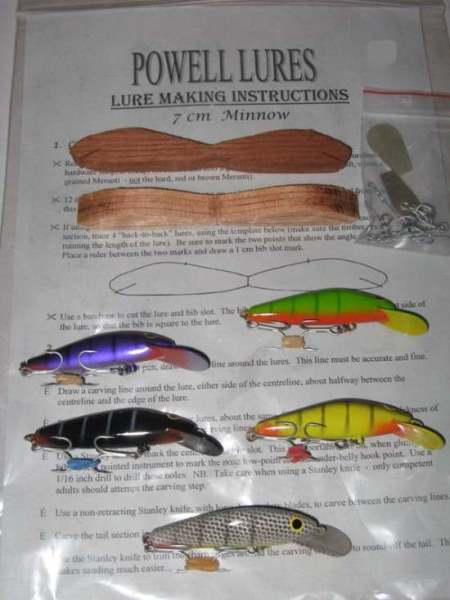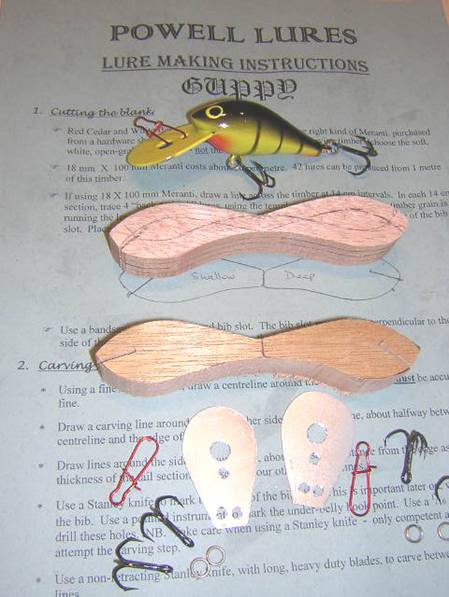Unique Aussie Lures

Ultimate Australian Fishing Lure Forum - LureLovers.com
Powell's Lures
by
Travers Powell
Like my self, Travers is ex classroom teacher so takes some pride in precision, accuracy and explanation, hence the design of his excellent Lure-Making Kit below and the detailed explanation of the process involved. We must applaud and commend his efforts to educate.
The Lure Making process
Australian Red Cedar has been the timber used in most of my lures. The
cedar has come from various sources, but most of it came from 2 huge cedar
doors that I bought when the original Tenterfield School buildings were
renovated and from a renovation job that my father-in-law did on the Railway
Hotel, in Armidale, about 30 years ago. The original Tenterfield School was
built in 1887 and the Railway Hotel was built in 1878, so the cedar used in
my lures is very old and has a little bit of history attached to it. I use
white beech and brown beech, when I can get it. I use meranti in the lure
making kits, because the soft, white meranti is like balsa to carve – easy
for new lure carvers to manage.
The process:
• Use templates to draw lure pattern onto timber. Most are
‘back-to-back’.
• Cut lure blanks out, using a bandsaw. Critical that bib slots must be
cut ‘square’ to the lure blank.
• Draw centreline and carving lines on the lure blank.
• Mark eyelet holes and drill. Use Stanley knife to mark centre of lure
at the bib slot.
• Carve the lures, first between the carving lines, then the tail and
finally trim the edges.
• Sand the lures, first, using 120 grit on a sanding block, then
finishing with 180 and 240 grit.
• Draw aluminium bib, using templates, drill holes, cut out, flatten and
file.
• Make eyelets, twisting the wire for extra strength.
• Glue lures, using Super Strength Araldite, injected into the holes.
Clean up excess glue.
• After glue has dried, sand lures with 180, 240 and 320 grit sand
paper.
• Undercoating. Lures are dipped in acrylic Primer Filler undercoat,
once a day for 5 days.
• Lures are tank tested and tuned
• Lures sanded back with 400 grit &/or 600 grit wet and dry sandpaper.
• Lures painted, using acrylic lacquer then given several coats of
acrylic lacquer clear. Eyes dotted.
• Random selection of lures tank tested. If any are not running properly,
the lot are tested & tuned.
• Tow points attached and soldered on bib-towed lures. Hooks attached.
POWELL LURES Catalog - 2010
Hand carved from red
cedar and brown beech.
VMC extra strength Perma-Steel
or
Barbarian treble hooks

Little Digger: deep diving lure for Cod, Yellowbelly and Bass. Body length 6cm

Mack Attack: Lure for small pelagic fish and barramundi. Body length 9.5cm

Macleay Minnow: Brilliant lure on Bass. Body length 6cm

Micro Digger: Deep diving tiny lure for Bream. Body length 4cm

Moogerah Minnow: Great on Bass, Yellowbelly and Flathead. Body length 7cm

Trout: Great lure on Bream and Trout. Body length 5cm
Lure Making kit: Designed to help get you started in lure making.

The kit includes: Instructions with templates, one double blank with carving lines drawn and holes drilled (to keep for future reference), a double blank (with bibs, eyelets, hooks and split rings for 2 lures) and a finished 7 cm minnow lure of your choice.

GUPPY Lure Making kit: Designed to help get you started in lure making.
The GUPPY was the first lure that Peter Newell taught me to make, back in 1989, when I moved to Tenterfield. The template allows you to make deep-diving and shallow-diving lures.
The kit includes: Instructions with templates, one double blank with carving lines drawn and holes drilled (to keep for future reference), a double blank (with bibs, eyelets, hooks and split rings for 2 lures) and a finished GUPPY lure of your colour choice.
I have chosen to remain a small time,
“cottage industry”, lure maker (I make about 150-250 lures each year)
because I don’t have the spare time to make large quantities of lures.
Also, Peter Newell advised me to remain small and to avoid the dramas that
he had with customers and other lure makers. I have never marketed my
lures, preferring to sell them from home, through friends and relatives and
from a stall that I have at the Maitland Caravan, Camping, 4WD, Fish and
Boat Show (May). In recent times, I have tried selling lures on ebay.
All of my lures are hand carved, mostly from very old Australian Red Cedar,
using the methods that Peter Newell showed me in 1989. Peter has passed on,
so I would like to maintain his traditional lure carving methods, to
preserve the craft and as a sign of respect for his help and friendship. To
help continue the craft of hand carving lures, the “Peter Newell” way, I
have put together two lure making kits. One is the 7cm Minnow and the other
is the Guppy. Hopefully, these will help to start a new generation of lure
carvers.

As he was taught,
Travers seeks to share the knowledge with a new generation.
My lures are now being sent to all parts of Australia. Some people
approached me to make them Kadaitchas, which, at first, I was hesitant to
do. Peter was always happy for me to make Kadaitchas, and I only made them
for my own use. When people asked to buy them from me, I would explain that
they weren’t my lure to sell – Peter found this amusing and said that he had
no problems with me selling them. Prior to 2009, I had only sold about 20
Kaditchas in the 20 years since Peter gave me the templates and showed me
how to make them. I explained to those enquiring that I had too much
respect for Peter to exploit his passing, but agreed to make the Kaditcha in
very limited numbers. In 2009, I made 10 sets of 2” and 3” Kaditchas and
sold 8. In 2010, I made 15 sets and sold 13, keeping the first 2 sets, in
both years, for family members. The Kaditchas will only be made in very
limited numbers each year.
Innovation and new designs? Most lure makers seek to develop a unique
design. I’m no different, but I am content to continue making lures that
are proven fish catchers. Sometimes, it’s little things that matter. For
example, in the early 90’s lure makers were trying to put lumps and bumps
into their lures to prevent the trebles linking together. I fixed the
problem by turning the rear eyelet (hook hanger) 90 degrees, so it was
horizontal rather than vertical – problem solved. The small top eyelet on
my bib tows, I turned 90 degrees, in the belief that it would help the
Tackleback attach to the lure better. Lack of time is a major factor that
prevents me experimenting with new designs, so the Little Digger, Micro
Digger, Mack Attack, Moogerah Minnow, Macleay Minnow and Trout, plus the 2
Lure Kits, is where I’m at in 2010.
I’m in the process of making some of the old lures that I used to make in
Tenterfield – a kind of retro-collection – which may be of interest to
anglers.
So that’s it – a fairly simple story. Started making lures to replace lures
lost to fish and snags. Ran into a bloke called Peter Newell and started
making really good quality lures, still to replace those lures lost to fish
and snags. An opportunity came to sell a few lures in the early 90’s and,
17-18 years later, I’m still making them in relatively small quantities -
so there should be about 3000-4000 Powell Lures hanging off drowned
trees/snags and in the bottom of tackle boxes, somewhere.
Cheers
Travers Powell
